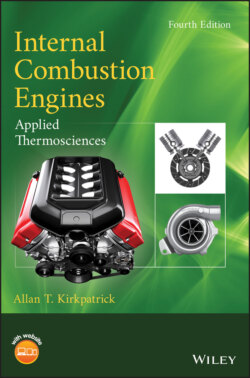Читать книгу Internal Combustion Engines - Allan T. Kirkpatrick - Страница 18
1.4 Engine Performance Parameters Engine Geometry
ОглавлениеA simple model of the crankshaft, connecting rod, piston, and head assembly of an engine cylinder is the flat‐top slider crank mechanism shown in Figure 1.6. Of particular interest are the following geometric parameters: bore , connecting rod length , crank radius , stroke , clearance height , and crank angle . The stroke is twice the crankshaft radius .
The term (tdc) of an engine refers to the crankshaft at a position = 0. The cylinder volume at this position is minimum and is called the clearance volume, . The term (bdc) refers to the crankshaft at a position = 180. The cylinder volume at bottom dead center is the maximum volume .
Figure 1.6 Engine slider crank geometry.
The compression ratio is defined as the ratio of the maximum to minimum volume.
(1.1)
The displacement volume is the difference between the maximum and minimum volume; for a single cylinder,
(1.2)
Useful expressions relating , , , and are
The piston clearance height at top dead center is
(1.5)
For multicylinder engines, the total displacement volume is the product of the number of cylinders, , and the volume of a single cylinder.
(1.6)
The mean piston speed is an important parameter in engine design since stresses and other factors scale with piston speed rather than with engine speed. Since the piston travels a distance of twice the stroke per revolution it should be clear that
(1.7)
The engine speed refers to the rotational speed of the crankshaft and is in units of revolutions per second or revolutions per minute (rpm). The engine frequency, , also refers to the rotation rate of the crankshaft but in units of radians per second. Examples 1.1 and 1.2 provide unit conversions for engine rpm.
